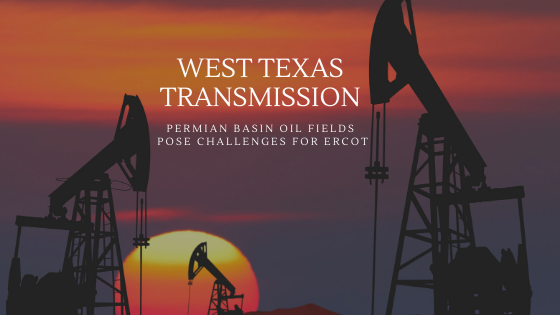 ____________
____________
“These projects are sufficient to meet the current load forecast through 2024, but if the load grows faster than currently forecast, there may be challenges to serve the load at that time.”
— Chad Seely, ERCOT General Counsel.
________________
Although boosting the overall economy, the booming West Texas oil and gas industry has created new challenges for ERCOT, the organization that manages the state’s primary power grid, a top official there reports.
As part of its responsibilities, the Electric Reliability Council of Texas identifies locations where utilities should site new transmission infrastructure. But in a recent memo to the state’s three Public Utility Commissioners, ERCOT general counsel Chad Seely noted that accelerated energy use from Permian Basin oil and gas production was ramping up so quickly that it made it difficult keeping pace.
 “Over the last couple of years, the ERCOT Board of Directors has endorsed several transmission projects … to support the load growth in this area,” he explained. “These projects are sufficient to meet the current load forecast through 2024, but if the load grows faster than currently forecast, there may be challenges to serve the load at that time.”
“Over the last couple of years, the ERCOT Board of Directors has endorsed several transmission projects … to support the load growth in this area,” he explained. “These projects are sufficient to meet the current load forecast through 2024, but if the load grows faster than currently forecast, there may be challenges to serve the load at that time.”
Seely noted that electricity demand in Far West Texas increased by approximately 700 megawatts over the last year, and that by the summer of 2019, load exceeded 4,000 MW for the first time in that area. He wrote that ERCOT anticipates the upward trend continuing.
But a timing disconnect between planning requirements for the oil and gas industry and planning requirements for transmission projects has complicated the ERCOT mission. According to Seely, major transmission projects typically take four to six years to complete, but the nature of the oil and gas industry makes it difficult to project resulting electric demand more than one to two years in advance.
“As a result, using the current processes, transmission planning studies are only able to accurately identify system needs one to two years in advance, which is not enough time to plan new major transmission improvements for the anticipated load growth,” wrote the ERCOT VP.
ERCOT staffers in recent months have met with West Texas utility officials and oil and gas customers to identify ways to address this planning gap. The stakeholders have proposed adjusting forecast scenarios for Far West Texas, changing generator assumptions and taking other technical steps.
Seely wrote that some proposals require ERCOT rules revisions, and others might require action from the Texas Public Utility Commission. “Each proposal can be considered individually or as a group, and they were all developed to bridge the timing gap between transmission build and oil and gas production and processing,” Seely wrote in his Dec. 5 memo.
You can read it in its entirety here.
